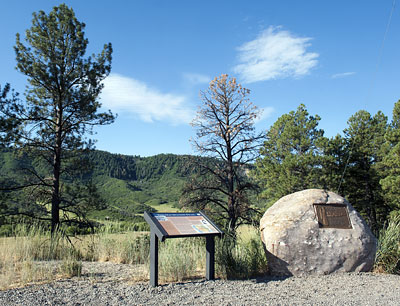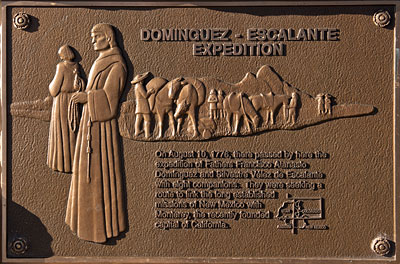Historic Points of Interest in La Plata County
 Both Photos 18 July 2010
Both Photos 18 July 2010
(Click Photos to Zoom)
 Dominguez - Escalante Expedition
Dominguez - Escalante Expedition
On August 10, 1776, there passed by here the expedition of Fathers Francisco Atanasio Domínguez and Silvestre Vélez de Escalante with eight companions. They were seeking a route to link the long established missions of New Mexico with Monterey, the recently founded capital of California.
US Route 160
San Juan National Forest
A San Juan Skyway interpretive placard reads in part:
Between August and December, 1776, Dominguez and Escalante and a small group of men attempted to find an overland route between the Spanish villages in New Mexico and the Spanish missions in California.The expedition crossed the La Plata River near what is now Hesperus. On August 10 and 11, 1776, Escalante wrote:
"...we swung through valleys of very beautiful timber and abundant pasturage, roses, and various other flowers...We were not able to move camp because Father Fray Francisco Atanasio awoke very weak...For this reason we were not able to go to see the veins and metallic stones of the sierra, although they were nearby, as we were assured by a companion who had seen them on another occasion."
Although Dominguez and Escalante did not reach California, they are recognized as the first Europeans to traverse and map what is now central Utah and cross the mighty Colorado River northeast of the Grand Canyon. Members of the expedition walked or rode horses nearly two thousand miles as they explored a relatively unknown land. Throughout their journey they encountered a dozen native tribes, yet they never resorted to violence toward their fellow man.

A second San Juan Skyway interpretive placard, captioned The Old Spanish Trail, reads in part:
Dominguez and Escalante traveled through this valley in 1776. Within twenty-five years of their expedition this trail became a regional trade route between the Spanish outposts in what is now California and New Mexico. Under the watchful eye of the Spanish government and later the Mexican government, both legal and illegal traders ventured deep into the Great Basin to barter with the Ute Indians. Sheep and textiles from New Mexico were traded for mules and horses in Southern California and brought back to Santa Fe. Livestock was later sold for use on the Santa Fe Trail - between Missouri and what is now New Mexico.One prominent traveler on the trail was Antoine Robidoux. He used this snow-free route to supply Fort Uncompahgre which he located on the Gunnison River. Robidoux traded cotton, blankets, tobacco, tea, coffee, knives, liquor ("Taos Lightning") and as occasional rifle to the Ute Indians in exchange for deer skin clothes, beaver pelts, and castoreum - a beaver scent gland that was used to make perfume and medicine.
Slaves were also traded and moved along the Old Spanish Trail. Ute, Paiute, and Navajo Indians, as well as young Hispanic women were often illegally bartered and sold as slaves in Colonial New Mexico.